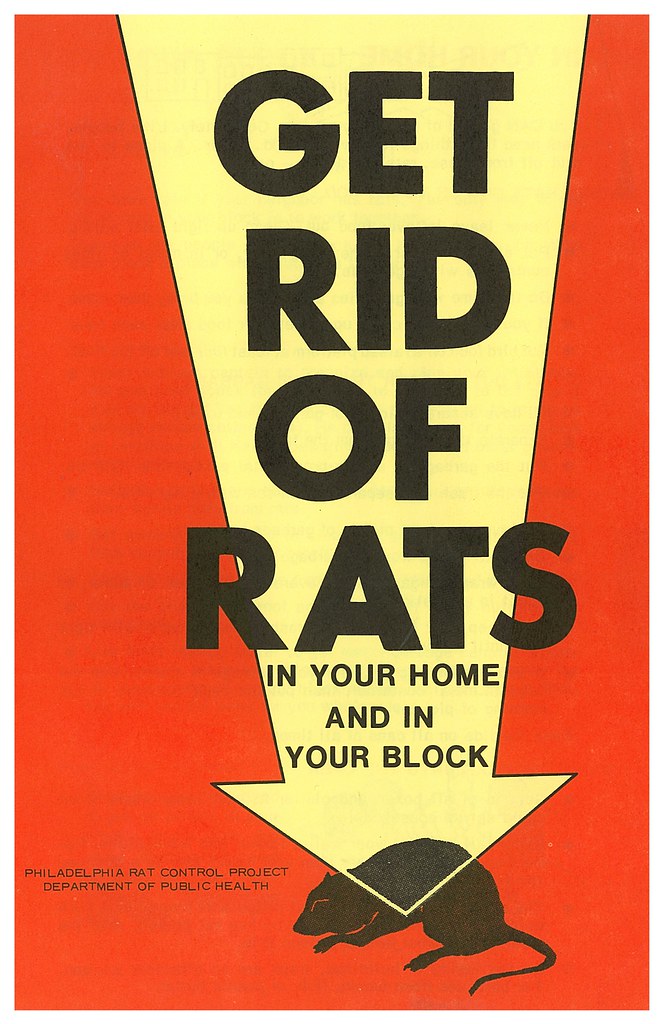Part of our ongoing Flashback Friday series with historian Adam Levine:
Our water has history, and connecting to that legacy helps Philly appreciate the centuries of work and generations of people it took to create the water system we depend on today.
See more #FBF from @PhillyH2O on Instagram
PWD historian Adam Levine has tales to tell of rodents in our sewers:

Adam Levine, PWD historian, does his best rat face with a copy of the 1971 Rat Control Report.
I got my start researching the history of Philadelphia’s water and sewer systems back in 1997, when I walked through a sewer in Northeast Philadelphia with Water Department staff and wrote about it for the now-defunct Philadelphia City Paper.
In honor of the last Friday the 13th of 2019, I thought something creepy might be a good flashback, so I’ve paraphrased the section of that article that focuses on the least-favorite creature of many city dwellers: rats!
Flashing my light up a foot-wide sewer pipe I surprised a small rat, which disappeared so quickly that nobody else saw it.
This was the only rat we saw on our walk, but I was assured that they abound in other areas underground. At the time, Sewer Maintenance Crew Chief William Stewart told me that some areas can be plagued by many rats residing in the pipes:
“You don't even want to go in the sewers down there,” he warned.
“Rat Out” Rats
If you see rats…
- On or near your residence.
- In the street.
- In a public park.
- In an alley or on the sidewalk.
Report rats by calling (215) 685-9000
Inspectors from the Department of Public Health will inspect the site, provide preventive treatment, and make recommendations to keep residences free of rodents. Inspectors will also provide information about mice, roaches, ticks, fleas, and other household pests.
If you see a rat in a food establishment, call the Office of Food Protection at (215) 685-7495
Visit the Health Department website to learn more.
Sewer inspector Isaiah Austin said that sewers in newer neighborhoods, where the houses have in-sink trash disposal systems, attract more rats because of the ground-up food.
“And they don't even have to chew,” joked industrial waste inspector Joe Cerrone.
“Rats are good swimmers, pretty good swimmers,” said sewer maintenance chief Richard Goode. “They don't like to swim, but they can. And they can climb anything.”
Charles Johnson, another crew chief with more than 20 years’ experience in sewer work, said rats are basically shy creatures that run away when they're discovered.
“The only time a rat might not run,” he said, “is when a worker crawling in a tight pipe gets between a mother rat and her nest. In that case, we tell them they should duck their head and let the rat run right over your back.”
Goode told a story about kneeling at the bottom of a manhole with a co-worker, facing down a rat that, for some reason, refused to run away. They whistled, threw stones, but the rat wouldn't budge. Then, they happened to look behind them and discovered they were almost sitting on the rat's nest.
“My foot was in one of the burrows,” he said. “It was this mound of dirt at the dead-end of the sewer, and there must have been about 25 rats.”
That particular sewer inspection was never completed. “We hauled %#@ out of there!” Goode said.
The biggest rat Goode ever saw was about 10 inches long, without the tail, and Stewart claimed to have seen rats that were “as big as a cat.” But as Cerrone observed, “Rats always look a lot bigger when they're alive than when they're dead.”
Read the full story, and see other adventures of the underground →
A Deeper Dive: Mayor Tate vs. the Rats
Mayor James Tate served Philly from 1962 to 1972, and launched the “Philadelphia Rat Control Project” in 1969.
In our archives, you will find a number of pamphlets that were produced during that era to help residents support the City efforts to deal with rodents. There's also a 1971 progress report that provides an in-depth look at the program. The year the program launched, 8,576 rat complaints were filed with the City…and 91 people reported rat bites.

